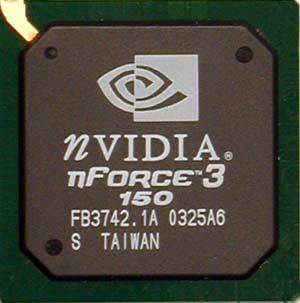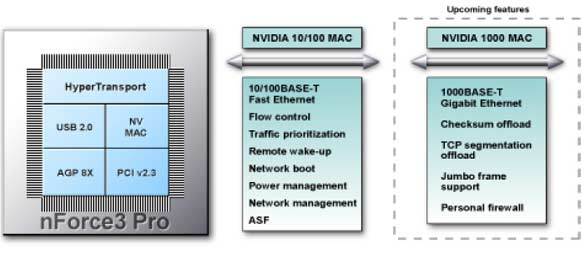The King of the Heap: 4 Chipsets for the Athlon64
NVIDIA nForce3 150
Please click for a larger image.
NVIDIA was the designated Launch Partner for the Athlon64, improving the edge it had already had over VIA thanks to the excellent performance of its nForce2 series. In fact, most of the boards you'll find are based on the nForce3 150.
The HyperTransport upstream suffers from one disadvantage: the nForce3 has a bandwidth of only 8 bits and a speed of 600 MHz, in contrast to the 16 bit bandwidth and 800 MHz it offers for downstream transfers. Unfortunately, this isn't the kind of flaw that can be eliminated with a quick BIOS update. Not to worry: the impact on real life performance is so small that you generally don't even notice it.
Where you can notice the drop in performance is in heavy OpenGL applications, as for example the results of SPECviewperf 7.1 demonstrate. However, using the latest platform driver 3.13 and NVIDIA's graphics driver revision 53.03 improves the performance disadvantage quite considerably, leaving only few benchmarks where nForce3 is outperformed by its competitors.
The nForce3 150 compensates for this weakness with StreamThru architecture based on HyperTransport. StreamThru can manage attached devices (e.g. LAN or audio) with regulated bandwidth allocation isochronously. This is a nifty feature for any kind of data stream that has to be transmitted without interruptions (e.g. a video stream).
Like the nForce3, the nForce3 150 allows you to clock your memory in a slew of different ratios to your system clock. You can set your PCI and AGP clocks to run both synchronously (traditional setting) or asynchronously at 33 and 66 MHz, respectively. This provides an excellent foundation for overclocking, especially since AMD has finally made it possible to tweak clock settings by providing an adjustable multiplier on the Athlon64 - assuming your board supports overclocking.
NVIDIA will soon launch a revamped version of the nForce3 chipset known as the nForce3 Pro 250. It is expected to bridge the performance gap and offer higher HyperTransport clock speeds. The new chip will also provide a Serial ATA controller and a Gigabit capable MAC interface. RAID functionality is another area where NVIDIA plans to catch up, offering RAID 0, 1 and 0+1. We found the official NVIDIA website to be a tad confusing because it simply adopts the new specifications without pointing out that they are actually for a new chipset.
Get Tom's Hardware's best news and in-depth reviews, straight to your inbox.
We ran our benchmarks on an nForce3 board from Shuttle, the AN50R. You can tell that Shuttle exploited every single feature offered by the nForce3 150: two UltraATA/133 ports, an AC97 sound system, a 100 Mbps network connector based on the nForce3 and a PHY (with an Intel Gigabit chip to boot), five PCI slots (one short of the maximum of six) and 6 USB 2.0 ports.
Jack-of-all-trades: the nForce3 150 has an AGP interface as well as all the components that you normally find in the Southbridge (audio, LAN, PCI, IDE, floppy, USB)
Gigabit Ethernet is on NVIDIA's to-do list as well

Patrick Schmid was the editor-in-chief for Tom's Hardware from 2005 to 2006. He wrote numerous articles on a wide range of hardware topics, including storage, CPUs, and system builds.


